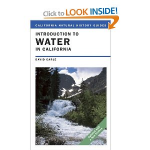
Until recently, a sixty mile span of the San Joaquin River ran dry every year, no matter how wet or dry the year. Chinook Salmon and Steelhead Trout populations declined precipitously. But because people got informed and involved, a more natural flow cycle has been restored for fish and fisheries. Salmon and Steelhead are returning to the river.
Over eighty percent of the water from the Tuolumne River has been diverted for agricultural and urban uses, yet there are those who argue these diversions have no harmful effects on salmon and the San Joaquin Delta. Nonetheless, because people got informed and involved, the Tuolumne River will soon have more water for fish and the Delta.
Land at the southwest corner of the San Joaquin Valley, ill-suited for agriculture from the beginning, now features ever higher concentrations of salt and nitrates, yet we continue to deliver precious water from the north to this alkaline desert where farming is less and less sustainable. Meanwhile, residents of Stanislaus and Merced Counties are facing a growing groundwater crisis.
Locally, it was only when the Modesto Irrigation District proposed a water sale to San Francisco that the general public began to take an interest in water. This year, the rapid depletion of the aquifer on the eastern edges of Stanislaus County became a story after The Valley Citizen did a series of reports beginning in April, 2013.
Water, once the dullest of subjects, has become an engrossing topic even to mainstream Valley media. But mainstream media seldom explain water issues in terms of the political realities that shape them.
Fortunately, new media have made it easier than ever to become well informed about water in our region. With a little background reading and periodic checking of key websites, any Valley citizen can become better informed about the political forces that have diverted water away from the public interest and toward their own ends.
David Carle’s Introduction to Water in California is still the quintessential reference for anyone interested in the hard facts about water in California. It’s a quick read (lots of pictures and maps), but if you’re in a hurry, read the last chapter only. It’s forty fact-filled pages entitled, “Meeting the Challenges: California’s Water Future.”
To begin to understand why water flows uphill toward money and power, there’s no better introduction than Lloyd Carter’s “Reaping Riches in a Wretched Region.” Carter is an award-winning journalist who has worked for United Press International and The Fresno Bee. His website, “Chronicles of the Hydraulic Brotherhood,” combines superb research and links to ongoing water stories of special interest to residents of the San Joaquin Valley.
Chris Austin, aka “Maven,” is the mastermind who created “Aquafornia,” a compendium of water-related news links that is now run by the Water Education Foundation. The Maven has gone on to produce “Maven’s Notebook,” a newsfeed with a special focus on the Bay Delta Conservation Plan and related water issues. If you want to know all there is to know about the Twin Tunnels proposal and its critics, “Maven’s Notebook” is the place to find out.
The history of water in California has been the story of a public resource appropriated and plundered by the few at the expense of the many. Absent an informed citizenry, this history will determine the future—a true tragedy of the commons. Fortunately, citizens now have the means to become better informed, the first step toward better protection of the public interest.
